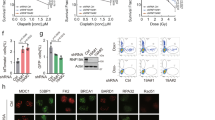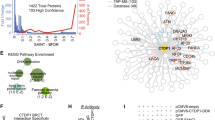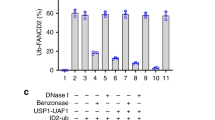Abstract
DNA interstrand crosslinks (ICLs) are extremely deleterious lesions that are repaired by homologous recombination (HR) through coordination of Fanconi anemia (FA) proteins and breast cancer susceptibility gene 1 (BRCA1) product, but the exact role these proteins have remains unclear. Here we report that FANCG was modified by the addition of lysine63-linked polyubiquitin chains (K63Ub) in response to DNA damage. We show that FANCG K63Ub was dispensable for monoubiquitination of FANCD2, but was required for FANCG to interact with the Rap80-BRCA1 (receptor-associated protein 80-BRCA1) complex for subsequent modulation of HR repair of ICLs induced by mitomycin C. Mutation of three lysine residues within FANCG to arginine (K182, K258 and K347, 3KR) reduced FANCG K63Ub modification, as well as its interaction with the Rap80-BRCA1 complex, and therefore impeded HR repair. In addition, we demonstrated that K63Ub-modified FANCG was deubiquitinated by BRCC36 complex in vitro and in vivo. Inhibition of BRCC36 resulted in increased K63Ub modification of FANCG. Taken together, our results identify a new role of FANCG in HR repair of ICL through K63Ub-mediated interaction with the Rap80-BRCA1 complex.
This is a preview of subscription content, access via your institution
Access options
Subscribe to this journal
Receive 50 print issues and online access
$259.00 per year
only $5.18 per issue
Buy this article
- Purchase on Springer Link
- Instant access to full article PDF
Prices may be subject to local taxes which are calculated during checkout







Similar content being viewed by others
References
Deans AJ, West SC . DNA interstrand crosslink repair and cancer. Nat Rev Cancer 2011; 11: 467–480.
Wang X, Peterson CA, Zheng H, Nairn RS, Legerski RJ, Li L . Involvement of nucleotide excision repair in a recombination-independent and error-prone pathway of DNA interstrand cross-link repair. Mol Cell Biol 2001; 21: 713–720.
Raschle M, Knipscheer P, Enoiu M, Angelov T, Sun J, Griffith JD et al. Mechanism of replication-coupled DNA interstrand crosslink repair. Cell 2008; 134: 969–980.
Knipscheer P, Raschle M, Smogorzewska A, Enoiu M, Ho TV, Scharer OD et al. The Fanconi anemia pathway promotes replication-dependent DNA interstrand cross-link repair. Science 2009; 326: 1698–1701.
Long DT, Raschle M, Joukov V, Walter JC . Mechanism of RAD51-dependent DNA interstrand cross-link repair. Science 2011; 333: 84–87.
Enoiu M, Jiricny J, Scharer OD . Repair of cisplatin-induced DNA interstrand crosslinks by a replication-independent pathway involving transcription-coupled repair and translesion synthesis. Nucleic Acids Res 2012; 40: 8953–8964.
Garcia-Higuera I, Taniguchi T, Ganesan S, Meyn MS, Timmers C, Hejna J et al. Interaction of the Fanconi anemia proteins and BRCA1 in a common pathway. Mol Cell 2001; 7: 249–262.
Wang W . Emergence of a DNA-damage response network consisting of Fanconi anaemia and BRCA proteins. Nat Rev Genet 2007; 8: 735–748.
Joenje H, Patel KJ . The emerging genetic and molecular basis of Fanconi anaemia. Nat Rev Genet 2001; 2: 446–457.
Tischkowitz MD, Hodgson SV . Fanconi anaemia. J Med Genet 2003; 40: 1–10.
Moldovan GL, D’Andrea AD . How the fanconi anemia pathway guards the genome. Annu Rev Genet 2009; 43: 223–249.
Smogorzewska A, Matsuoka S, Vinciguerra P, McDonald ER III, Hurov KE, Luo J et al. Identification of the FANCI protein, a monoubiquitinated FANCD2 paralog required for DNA repair. Cell 2007; 129: 289–301.
Rahman N, Seal S, Thompson D, Kelly P, Renwick A, Elliott A et al. PALB2, which encodes a BRCA2-interacting protein, is a breast cancer susceptibility gene. Nat Genet 2007; 39: 165–167.
Kim Y, Lach FP, Desetty R, Hanenberg H, Auerbach AD, Smogorzewska A . Mutations of the SLX4 gene in Fanconi anemia. Nat Genet 2011; 43: 142–146.
Stoepker C, Hain K, Schuster B, Hilhorst-Hofstee Y, Rooimans MA, Steltenpool J et al. SLX4, a coordinator of structure-specific endonucleases, is mutated in a new Fanconi anemia subtype. Nat Genet 2011; 43: 138–141.
Vaz F, Hanenberg H, Schuster B, Barker K, Wiek C, Erven V et al. Mutation of the RAD51C gene in a Fanconi anemia-like disorder. Nat Genet 2010; 42: 406–409.
Nakanishi K, Cavallo F, Perrouault L, Giovannangeli C, Moynahan ME, Barchi M et al. Homology-directed Fanconi anemia pathway cross-link repair is dependent on DNA replication. Nat Struct Mol Biol 18: 500–503.
Nakanishi K, Yang YG, Pierce AJ, Taniguchi T, Digweed M, D’Andrea AD et al. Human Fanconi anemia monoubiquitination pathway promotes homologous DNA repair. Proc Natl Acad Sci USA 2005; 102: 1110–1115.
Niedzwiedz W, Mosedale G, Johnson M, Ong CY, Pace P, Patel KJ . The Fanconi anaemia gene FANCC promotes homologous recombination and error-prone DNA repair. Mol Cell 2004; 15: 607–620.
Thompson LH, Hinz JM . Cellular and molecular consequences of defective Fanconi anemia proteins in replication-coupled DNA repair: mechanistic insights. Mutat Res 2009; 668: 54–72.
Zhang N, Liu X, Li L, Legerski R . Double-strand breaks induce homologous recombinational repair of interstrand cross-links via cooperation of MSH2, ERCC1-XPF, REV3, and the Fanconi anemia pathway. DNA Repair (Amst) 2007; 6: 1670–1678.
Deans AJ, West SC . FANCM connects the genome instability disorders Bloom’s syndrome and fanconi anemia. Mol Cell 2009; 36: 943–953.
Rothfuss A, Grompe M . Repair kinetics of genomic interstrand DNA cross-links: evidence for DNA double-strand break-dependent activation of the Fanconi anemia/BRCA pathway. Mol Cell Biol 2004; 24: 123–134.
Akkari YM, Bateman RL, Reifsteck CA, Olson SB, Grompe M . DNA replication is required to elicit cellular responses to psoralen-induced DNA interstrand cross-links. Mol Cell Biol 2000; 20: 8283–8289.
Dronkert ML, Kanaar R . Repair of DNA interstrand cross-links. Mutat Res 2001; 486: 217–247.
Karran P . DNA double strand break repair in mammalian cells. Curr Opin Genet Dev 2000; 10: 144–150.
Yang YG, Herceg Z, Nakanishi K, Demuth I, Piccoli C, Michelon J et al. The Fanconi anemia group A protein modulates homologous repair of DNA double-strand breaks in mammalian cells. Carcinogenesis 2005; 26: 1731–1740.
Folias A, Matkovic M, Bruun D, Reid S, Hejna J, Grompe M et al. BRCA1 interacts directly with the Fanconi anemia protein FANCA. Hum Mol Genet 2002; 11: 2591–2597.
Yamamoto K, Ishiai M, Matsushita N, Arakawa H, Lamerdin JE, Buerstedde JM et al. Fanconi anemia FANCG protein in mitigating radiation- and enzyme-induced DNA double-strand breaks by homologous recombination in vertebrate cells. Mol Cell Biol 2003; 23: 5421–5430.
Wilson JB, Yamamoto K, Marriott AS, Hussain S, Sung P, Hoatlin ME et al. FANCG promotes formation of a newly identified protein complex containing BRCA2, FANCD2 and XRCC3. Oncogene 2008; 27: 3641–3652.
Narod SA, Foulkes WD . BRCA1 and BRCA2: 1994 and beyond. Nat Rev Cancer 2004; 4: 665–676.
Venkitaraman AR . Cancer susceptibility and the functions of BRCA1 and BRCA2. Cell 2002; 108: 171–182.
Roy R, Chun J, Powell SN . BRCA1 and BRCA2: different roles in a common pathway of genome protection. Nat Rev Cancer 2012; 12: 68–78.
Greenberg RA, Sobhian B, Pathania S, Cantor SB, Nakatani Y, Livingston DM . Multifactorial contributions to an acute DNA damage response by BRCA1/BARD1-containing complexes. Genes Dev 2006; 20: 34–46.
Wang B, Matsuoka S, Ballif BA, Zhang D, Smogorzewska A, Gygi SP et al. Abraxas and RAP80 form a BRCA1 protein complex required for the DNA damage response. Science 2007; 316: 1194–1198.
Yu X, Chen J . DNA damage-induced cell cycle checkpoint control requires CtIP, a phosphorylation-dependent binding partner of BRCA1 C-terminal domains. Mol Cell Biol 2004; 24: 9478–9486.
Shao G, Patterson-Fortin J, Messick TE, Feng D, Shanbhag N, Wang Y et al. MERIT40 controls BRCA1-Rap80 complex integrity and recruitment to DNA double-strand breaks. Genes Dev 2009; 23: 740–754.
Sobhian B, Shao G, Lilli DR, Culhane AC, Moreau LA, Xia B et al. RAP80 targets BRCA1 to specific ubiquitin structures at DNA damage sites. Science 2007; 316: 1198–1202.
Feng L, Huang J, Chen J . MERIT40 facilitates BRCA1 localization and DNA damage repair. Genes Dev 2009; 23: 719–728.
Kim H, Huang J, Chen J . CCDC98 is a BRCA1-BRCT domain-binding protein involved in the DNA damage response. Nat Struct Mol Biol 2007; 14: 710–715.
Kim H, Chen J, Yu X . Ubiquitin-binding protein RAP80 mediates BRCA1-dependent DNA damage response. Science 2007; 316: 1202–1205.
Wang B, Hurov K, Hofmann K, Elledge SJ . NBA1, a new player in the Brca1 A complex, is required for DNA damage resistance and checkpoint control. Genes Dev 2009; 23: 729–739.
Coleman KA, Greenberg RA . The BRCA1-RAP80 complex regulates DNA repair mechanism utilization by restricting end resection. J Biol Chem 2011; 286: 13669–13680.
Hu Y, Scully R, Sobhian B, Xie A, Shestakova E, Livingston DM . RAP80-directed tuning of BRCA1 homologous recombination function at ionizing radiation-induced nuclear foci. Genes Dev 2011; 25: 685–700.
Shao G, Lilli DR, Patterson-Fortin J, Coleman KA, Morrissey DE, Greenberg RA . The Rap80-BRCC36 de-ubiquitinating enzyme complex antagonizes RNF8-Ubc13-dependent ubiquitination events at DNA double strand breaks. Proc Natl Acad Sci USA 2009; 106: 3166–3171.
Feng L, Wang J, Chen J . The Lys63-specific deubiquitinating enzyme BRCC36 is regulated by two scaffold proteins localizing in different subcellular compartments. J Biol Chem 2010; 285: 30982–30988.
Cooper EM, Cutcliffe C, Kristiansen TZ, Pandey A, Pickart CM, Cohen RE . K63-specific deubiquitination by two JAMM/MPN+ complexes: BRISC-associated Brcc36 and proteasomal Poh1. EMBO J 2009; 28: 621–631.
Dikic I, Wakatsuki S, Walters KJ . Ubiquitin-binding domains—from structures to functions. Nat Rev Mol Cell Biol 2009; 10: 659–671.
Sato Y, Yoshikawa A, Mimura H, Yamashita M, Yamagata A, Fukai S . Structural basis for specific recognition of Lys 63-linked polyubiquitin chains by tandem UIMs of RAP80. EMBO J 2009; 28: 2461–2468.
Sims JJ, Cohen RE . Linkage-specific avidity defines the lysine 63-linked polyubiquitin-binding preference of rap80. Molecular cell 2009; 33: 775–783.
Huang TT, D’Andrea AD . Regulation of DNA repair by ubiquitylation. Nat Rev Mol Cell Biol 2006; 7: 323–334.
Weake VM, Workman JL . Histone ubiquitination: triggering gene activity. Mol Cell 2008; 29: 653–663.
Clague MJ, Urbe S . Endocytosis: the DUB version. Trends Cell Biol 2006; 16: 551–559.
Liu Z, Wu J, Yu X . CCDC98 targets BRCA1 to DNA damage sites. Nat Struct Mol Biol 2007; 14: 716–720.
Cooper EM, Boeke JD, Cohen RE . Specificity of the BRISC deubiquitinating enzyme is not due to selective binding to Lys63-linked polyubiquitin. J Biol Chem 2010; 285: 10344–10352.
D’Andrea AD, Grompe M . The Fanconi anaemia/BRCA pathway. Nat Rev Cancer 2003; 3: 23–34.
Wang B, Elledge SJ . Ubc13/Rnf8 ubiquitin ligases control foci formation of the Rap80/Abraxas/Brca1/Brcc36 complex in response to DNA damage. Proc Natl Acad Sci USA 2007; 104: 20759–20763.
Yan Z, Guo R, Paramasivam M, Shen W, Ling C, Fox D III, et al. A ubiquitin-binding protein, FAAP20, links RNF8-mediated ubiquitination to the Fanconi anemia DNA repair network. Mol Cell 2012; 47: 61–75.
Feng L, Chen J . The E3 ligase RNF8 regulates KU80 removal and NHEJ repair. Nat Struct Mol Biol 2012; 19: 201–206.
Bunting SF, Callen E, Wong N, Chen HT, Polato F, Gunn A et al. 53BP1 inhibits homologous recombination in Brca1-deficient cells by blocking resection of DNA breaks. Cell 2010; 141: 243–254.
Ward IM, Reina-San-Martin B, Olaru A, Minn K, Tamada K, Lau JS et al. 53BP1 is required for class switch recombination. J Cell Biol 2004; 165: 459–464.
Huen MS, Grant R, Manke I, Minn K, Yu X, Yaffe MB et al. RNF8 transduces the DNA-damage signal via histone ubiquitylation and checkpoint protein assembly. Cell 2007; 131: 901–914.
Kolas NK, Chapman JR, Nakada S, Ylanko J, Chahwan R, Sweeney FD et al. Orchestration of the DNA-damage response by the RNF8 ubiquitin ligase. Science 2007; 318: 1637–1640.
Mailand N, Bekker-Jensen S, Faustrup H, Melander F, Bartek J, Lukas C et al. RNF8 ubiquitylates histones at DNA double-strand breaks and promotes assembly of repair proteins. Cell 2007; 131: 887–900.
Zhao GY, Sonoda E, Barber LJ, Oka H, Murakawa Y, Yamada K et al. A critical role for the ubiquitin-conjugating enzyme Ubc13 in initiating homologous recombination. Mol Cell 2007; 25: 663–675.
Hussain S, Witt E, Huber PA, Medhurst AL, Ashworth A, Mathew CG . Direct interaction of the Fanconi anaemia protein FANCG with BRCA2/FANCD1. Hum Mol Genet 2003; 12: 2503–2510.
Davies AA, Masson JY, McIlwraith MJ, Stasiak AZ, Stasiak A, Venkitaraman AR et al. Role of BRCA2 in control of the RAD51 recombination and DNA repair protein. Mol Cell 2001; 7: 273–282.
Moynahan ME, Pierce AJ, Jasin M . BRCA2 is required for homology-directed repair of chromosomal breaks. Mol Cell 2001; 7: 263–272.
Hofmann K . Ubiquitin-binding domains and their role in the DNA damage response. DNA Repair (Amst) 2009; 8: 544–556.
Kratz K, Schopf B, Kaden S, Sendoel A, Eberhard R, Lademann C et al. Deficiency of FANCD2-associated nuclease KIAA1018/FAN1 sensitizes cells to interstrand crosslinking agents. Cell 2010; 142: 77–88.
MacKay C, Declais AC, Lundin C, Agostinho A, Deans AJ, MacArtney TJ et al. Identification of KIAA1018/FAN1, a DNA repair nuclease recruited to DNA damage by monoubiquitinated FANCD2. Cell 2010; 142: 65–76.
Smogorzewska A, Desetty R, Saito TT, Schlabach M, Lach FP, Sowa ME et al. A genetic screen identifies FAN1, a Fanconi anemia-associated nuclease necessary for DNA interstrand crosslink repair. Mol Cell 2010; 39: 36–47.
Acknowledgements
This work was supported by Beijing Natural Science Foundation (Grant 7122099); Natural Science Foundation of China (Grant 81272915); the Research Fund for the Doctoral Program of Higher Education (20110001110013); the Project Sponsored by the Scientific Research Foundation for the Returned Overseas Chinese Scholars, State Education Ministry (JWSL44-8); 985 Program, Ministry of Education of China.
Author information
Authors and Affiliations
Corresponding authors
Ethics declarations
Competing interests
The authors declare no conflict of interest.
Additional information
Supplementary Information accompanies this paper on the Oncogene website
Supplementary information
Rights and permissions
About this article
Cite this article
Zhu, B., Yan, K., Li, L. et al. K63-linked ubiquitination of FANCG is required for its association with the Rap80-BRCA1 complex to modulate homologous recombination repair of DNA interstand crosslinks. Oncogene 34, 2867–2878 (2015). https://doi.org/10.1038/onc.2014.229
Received:
Revised:
Accepted:
Published:
Issue Date:
DOI: https://doi.org/10.1038/onc.2014.229
This article is cited by
-
Role of K63-linked ubiquitination in cancer
Cell Death Discovery (2022)
-
Associations of complementation group, ALDH2 genotype, and clonal abnormalities with hematological outcome in Japanese patients with Fanconi anemia
Annals of Hematology (2019)
-
DNA damage response and cancer therapeutics through the lens of the Fanconi Anemia DNA repair pathway
Cell Communication and Signaling (2017)
-
Cellular response to DNA interstrand crosslinks: the Fanconi anemia pathway
Cellular and Molecular Life Sciences (2016)



